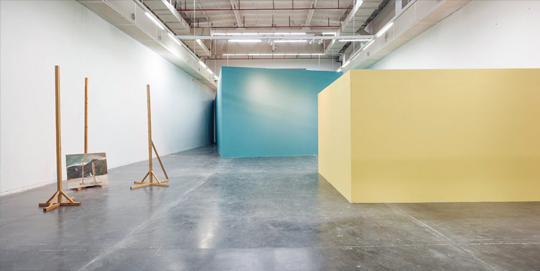QIU XIAOFEI: REPETITION
| June 4, 2013 | Post In LEAP 20

After first passing through a black room, the viewer discovers that the large exhibition hall actually contains three rooms, each painted a different color. The middle room is yellow. A blue room, multi-angled, juts out from one end of the gallery, its walls seemingly transparent and spectral. Only one work is placed outside of the three hued exhibition spaces— Mountain Behind Wood Behind Mountain (2012). It is composed of three tall wooden stands and an oil painting on wooden board, which leans against the base of one stand. The painting depicts a view similar to the scene staged in the space. In the painting, with mountains in the background, three wood- en stands— like the real life ones placed around the painting—surround a table atop which is a cone that gives off a metallic sheen. This work was first shown in a group show at the Boers-Li Gallery. Here, a small staging change was made: the painting and the stand it leans on have been moved from being closer to the viewer to further away from the viewer.
In comparison, for the paintings displayed in the black room—collected in Qiu Xiaofei’s 2006 catalogue Heilongjiang Box— the focal point was the speculative relationship between object and its likeness. The objects are all related to the artist’s experiences of growing up, including photographs, photo albums, Chinese checkers sets, printed materials, and so on. As a medium for constructing time (memory), Qiu uses representations of texture to awaken these objects from silence. Nevertheless, the strong sense of physical presence does not transcend the boundaries of the picture frame. The black wall seems to suggest the heavy ineffability of time, while it simultaneously eliminates the paintings’ physicality in a two-dimensional visual experience. But in Mountain Behind Wood Behind Mountain, the physical objects (wood frames) intrude into the scene. As a result, when the viewer moves through the gallery their perception of space shifts, becoming compressed or expansive, thus forming a non-physically material visual trajectory. Following along this external orbit, the space that is subordinate to the painting leaps out from inside the picture frame to interact with the Euclidean space in reality, agitating the viewer’s previously stable spatial awareness. The small adjustment in placement made in this exhibition further intensifies this disturbance.
Mountain Behind Wood Behind Mountain marks an endpoint for Qiu Xiaofei’s recent painting practice, and inspires the direction his subsequent works take— abandonment of the primacy of the image in painting. Qiu attempts to move painting away from actions happening inside the picture frame, instead and toward a process of thoughtful pensive consciousness. Rather than accept that paintings are passive, flat physical spaces, he tries to make them into active, indeterminate, yet conscious spaces. And so the images in Qiu’s works are transformed into anchors of a nonlinear and logical dynamic that mark the depth of consciousness. The artistic practice resulting from this transformation is collectively exhibited inside the blue room, where preexisting physical objects are appended to a majority of the works. These heterogeneous elements that do not belong to the painting are also referents for the practice of painting itself. Take for example Plus Minus, in which hooks replace eyes, and fruits made out of stone are affixed to the scale, which is painted onto the canvas. After breaking away from the trajectory of reality, these objects are linguistic characterizations of the loss of gravity within the textuality of painting.
If viewed from the composition of the paintings, the black room’s expression of time, and the blue room’s expansion of spatial awareness, together the two rooms form a structural logic for viewing the exhibition. However, when entering the yellow room, this viewing logic that the viewer has recently established is broken. On exhibit are drawings and other works that Qiu made in his youth— when he first learned to paint and draw. These works appear ordinary, and seemingly nearly unable to be securely inserted into the exhibition’s structure. Yet considering the exhibition’s title, “Repetition,” the yellow room is perhaps not what Qiu has described as the pre-consciousness— which represents painting— but more like Qiu is savoring the joy that painting had first given him. This is perhaps the physical momentum that drives his memory to “turn to the future.” (Translated by JiaJing Liu)

